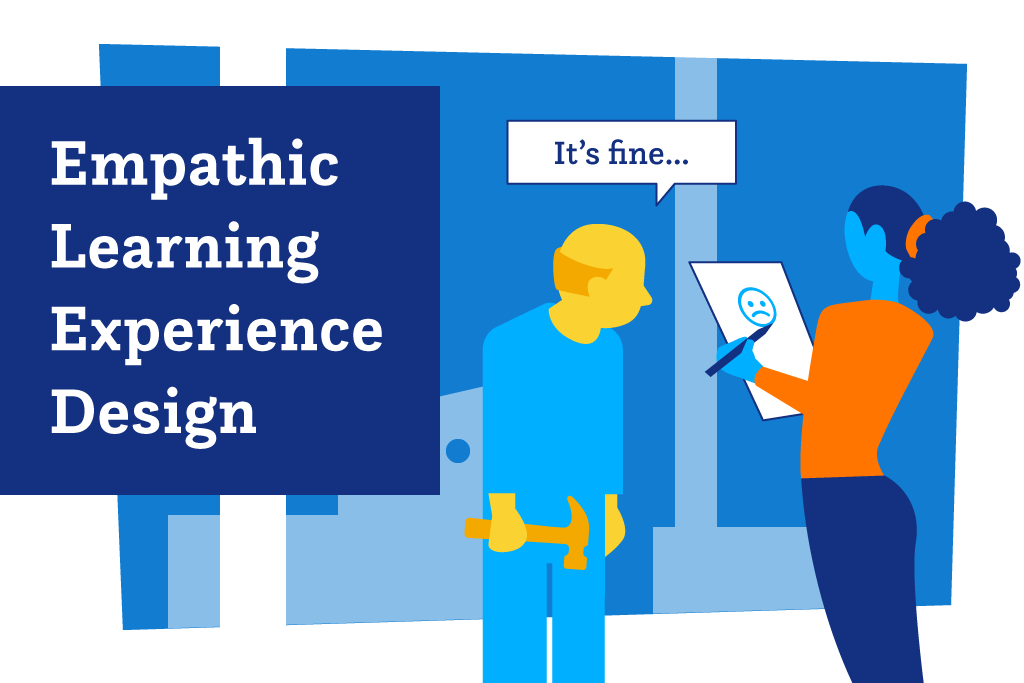August 24 2023 – Niels Floor |
Having empathy for the people you design for is vital for the creation of a personal and purposeful learning experience. What is empathy and why is it important for learning experience design?
According to Merriam Webster Dictionary empathy is “the action of understanding, being aware of, being sensitive to, and vicariously experiencing the feelings, thoughts, and experience of another.” In other words, empathy is about walking in another person’s shoes. Empathy enables you to understand and feel what someone is going through on an emotional, cognitive, and experiential level. That’s pretty important if you design a learning experience.
Empathy is a skill
Empathy isn’t easy. Just like creativity, empathy is a skill. There’s a big difference between being called creative by your parents or teacher when you’re young and being a creative professional when you grow up. Similarly, some children are more empathic than others, but empathy also needs to be developed if you want to become an empathic designer.
It’s important to be aware of potential downsides to empathy. The main downside is our tendency to be more empathic towards people that we are familiar with or people that are more like us. Having empathy for your best friend is generally easier than having empathy for a total stranger. Especially when that stranger looks totally different from you. History has taught us how empathy for one group can install hate for one another. In times of conflict, we pick sides, which can lead to horrible situations like fights, riots, or wars.
Having empathy for someone who’s different from you takes effort. As a designer, it’s important to be aware of possible bias in empathy. You want to be able to empathise with any person you design for, no matter where they come from and what they look like. Designers are taught to put their personal preferences aside and open their minds and souls to their target audience. I always remind myself of the design mantras “you are not the person you are designing for” and “a designer is not a typical user.” Knowing that you are different in many ways from the people that you serve, enables you to be open minded and genuinely interested in other people’s lives, needs, struggles, and joys. That’s why we do design research!
Using empathy as a professional also applies to dealing with strong emotions. Doctors have empathy for their patients while keeping a professional distance from the pain and suffering they witness. If they would empathise with all their patients in the same way they empathise with their loved ones, the job would become unbearable. The same principle applies to designers. You want to keep a professional distance to do your work properly.
Design for emotion
Emotion is a big part of how we experience and how we learn from what we experience. Empathising with the learner is an important part of the process of designing a learning experience. It enables you to design for emotion in a way that empowers the learner. When learners deal with negative emotions you can address them in your design and work on them. For example, taking a test can be scary and overcoming that fear will boost performance. Turning negative emotions into positive ones makes a learning experience highly memorable. You can use positive emotions to further motivate and excite learners. For example, learners who are excited to get started love a good challenge to demonstrate their eagerness to learn and to perform well. This can also inspire others who may be in a negative or neutral state of mind.
Whatever learners may feel, your goal is to design a learning experience that deals with their emotions in an empathic and intelligent way. Being empathic in your approach enables you to understand the learner in a more profound way.
Boost your empathic design skills
If you want to develop and apply empathic learning experience design skills try this:
- When you interview or observe learners, don’t just listen to what is said but also listen to how it is said.
- Facial expressions, body language and tone of voice tell their own story, look carefully to discover how people feel.
- Don’t be afraid to ask about people’s feelings and follow up if you want to know more.
- Take your time and don’t rush into any conclusions as many people will only open up after some time.
- Sense the atmosphere in the room to get a feel for the situation your learners are in.
- Reflect on how the stories and observations of your learners make you feel.
- Capture your findings using the empathy map for learners.
- Remember, empathy isn’t everything, don’t forget about objective observations and practical matters.
Good luck and enjoy the journey!


Comments
Niels, this is excellent. I have accessed the Empathy Map for Learners and plan to use it as we refresh a few faculty development courses.